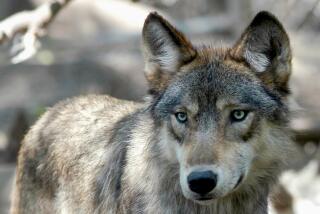Moose thrive, multiply in human-altered environment
- Share via
BOISE, IDAHO — When moose sauntered out of the last Ice Age, they left behind an array of extinct species. Wooly mammoths, sabertooth cats, dire wolves, huge short-faced bears, and the very similar stag-moose.
Modern-day moose are still on the move. Experts say they’re now thriving in a new landscape where habitat changes -- spurred by human influences -- have allowed them to break out of isolated strongholds.
“Forty years ago a moose was like an exotic -- it was like a giraffe. Nobody had any moose,” said Ed Mitchell, information supervisor with the Idaho Department of Fish and Game. “They’ve really spread since then.”
Lewis and Clark never saw a moose when they crossed Idaho 200 years ago, and trappers’ journals note moose as rare occurrences, said Dale E. Toweill of Idaho Fish and Game.
In 1939, Idaho had 1,000 moose. Today, the state has an estimated population of 15,000 to 25,000 Shiras moose, more than any other state.
The Shiras moose is the smallest subspecies, inhabiting parts of the Rocky Mountain West. A bull averages less than 800 pounds -- about half the size of an Alaska Yukon moose.
Experts say smaller moose can better cope with warmer temperatures and live farther south. The result is booming populations across the region. Wyoming now has as many as 10,000 moose, Utah has about 4,500, Montana is home to 5,000, and Washington has about 1,000, mostly in the northeast corner of the state.
“Moose may have been at low densities [200 years ago],” said Joel Berger, a senior scientist with the New York-based Wildlife Conservation Society and a professor at the University of Montana. “Certainly not at the densities we see today.”
Logging and development are credited with opening up areas and allowing the growth of shrubs, the main ingredient in a moose’s diet. At the same time, predators were largely killed off from wide areas of moose territory.
“Habitat disturbance caused by industry has favored some wildlife species, moose being one,” said Berger, who conducted a 10-year study of moose in Grand Teton National Park. “And with the historic loss of grizzly bears and wolves, until the 1990s, there were huge areas of Idaho that had good vegetation and no large carnivores.
“Moose are all of a sudden like a kid in a candy store,” he said.
Moose tend to be solitary animals that don’t form herds. And despite a droll appearance that lends itself to cartoon characters and a brisk trinket trade in national parks, they have unique survival strategies that helped them outlive the fearsome beasts they coexisted with during the last Ice Age.
Females give birth at the same time but far apart from each other. That limits how many calves could be killed by predators, Berger said, and female moose will defend their young.
The population boom has been a boon for hunters, who have made them one of the most sought-after big game animals in states were they exist. Hunting permits are limited, and some states restrict them to once in a lifetime.
The question is how long the boom can last.
In states where wolves and grizzlies are rebounding, biologists wonder how many moose are falling victim to these predators. Berger’s study found that 2% of moose deaths in Grand Teton National Park were due to wolves. About 15% died from grizzly attacks.
The rest fell victim to starvation, hunters or vehicle accidents.
Warming temperatures could hinder moose populations, particularly along the southern tier of their current range, since the animals don’t care for temperatures above 55 degrees.
Changing logging practices also could mean changes for the moose, Berger said.
Logged forests tend to produce the kind of browse moose like for about 10 to 30 years, before it’s not productive for moose. However, logging has slowed in some areas.
In Utah, most of the moose are in the northeastern part of the state, said Anis Aoude, big-game coordinator with the Utah Division of Wildlife Resources.
“The population has been going up steadily since the 1930s or so,” he said. “I think it’s just different land-use patterns. Logging and so on has created better habitat. But current land use has kind of changed, so we’ve reached the point where we’re no longer growing our moose herd so much.”
Therein lies one more threat: human population expanding into moose habitat. Moose encounters with humans are growing in some areas.
“With habitat constantly declining, I suspect we’re at the limit of what moose can do” in Idaho, Toweill said. “But who knows, they’re a surprising animal.”
More to Read
Sign up for Essential California
The most important California stories and recommendations in your inbox every morning.
You may occasionally receive promotional content from the Los Angeles Times.













